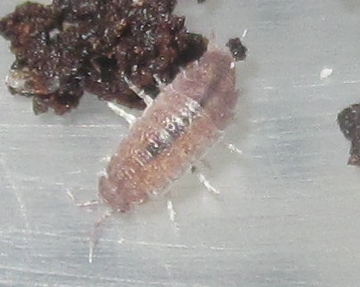A couple months ago I got a series of small isopod species from hobbyist and scientist Nathan Jones, who's been an instrumental part of the isopod hobby as a whole in terms of properly keying out and identifying species coming into the hobby.
First off, and probably my favorite TBH, he sent me a group of Proporcellio vulcanius "Glen Rose, TX". This cute species is a somewhat recent addition to the hobby, and not widely kept ATM. I gotta say, they are very pretty, with nice patterning and some beautiful base coloration. Definitely an underrated species IMO, that definitely looks better in person. Size wise they are about the size of Porcellionides pruinosus, but flatter and broader. They seem to prefer a semi-humid setup, with decent ventilation. They are also a very prolific species, I've gotten dozens of offspring so far and they are growing well.
I have mine set up in a well ventilated gallon shoebox with an inch or so of old roach substrate (mainly coconut fiber with a little leaf litter and of course roach frass mixed in), topped with bark hides and leaf litter. In addition to the litter they're being fed dog food. I'm keeping them at around 75F°, and on a 50/50 horizontal humidity gradient.
Here are some pictures of them:
A very subtly attractive species in my opinion, one I hope becomes more popular in culture. 😀
Next up, he sent a group of Trichorhina sp. "Puerto Rico". These are a much faster moving, more slender and longer legged species compared to T.tomentosa, with a glossy exoskeleton rather than the more textured, matte exoskeletons of tomentosa. Not sure if they're parthenogenetic or not, I kinda assume they are but I could be wrong. They are definitely fast breeders, as I have already gotten offspring from mine.
I've got mine set up in a minimally ventilated container with an inch of moist old roach substrate, and I'm feeding them primarily dog food. Temperature is about 75F° in their setup.
Here are some pictures of a group:
I like the look of these way more than T.tomentosa, and they seem equally as hardy... so that said their enclosure is escape proof and being kept far away from my other isopods. 🤣
Nathan also sent a group of Haplophthalmus danicus "New Church, VA". This diminutive species is rather plain in appearance, slow moving and plays dead upon being disturbed. They also reportedly are pretty reliant on rotten wood in their diet, and don't love very warm temps from what I've heard.
I have my culture set up on a mix of old roach substrate and flake soil, with some rotten wood chunks mixed in, topped with crushed leaf litter. I'm offering dog food as a supplemental food source, but they don't really touch it much. Temps are in the 70-75F° range.
Here are a few of the best pics I could get of this species, they are so small and their whole curling up and playing dead thing made getting pictures difficult:
A cute little species for sure, and a neat addition to the collections of those keepers who like collecting small, obscure and oddball species (like myself). 😄
Nathan also sent me two localities of Miktoniscus cf. medcofi, one from Alabama and one from Texas. No significant differences between the two localities that I can tell, but hey, the more localities in culture the merrier I suppose!
This is yet another micro-pod, but while their coloration is rather plain, varying from tan to darker grey-brown, their morphology is quite unique, very elongated and cylindrical, almost reminiscent of a tiny version of Hemilepistus spp..
I've got both my cultures in minimally ventilated containers with an inch of old roach substrate topped with leaf litter, kept quite humid. I'm also offering dog food for protein, and keeping them at around 75F°.
Here are some pictures of both strains:
 |
| Texas Strain |
 |
| Alabama Strain |
Definitely a neat little species, again not very commonly kept in culture, but one I think is deserving of a spot in the isopod enthusiast's collection. 🙂
Lastly, he sent me some Ligidum elrodii, however those did not last long for me at all, I think I kept them too warm initially, and also botched the humidity levels. So that kinda sucks, since it was quite a cool little species, didn't even get to snap any pictures before I lost them all.
Well, that does it for this post, thanks for reading, hope everyone enjoyed, and I'll see you fine folks next time! 😉





































Would you be nice enough to check for (or, if you've checked, talk about the easiness or lack thereof of) Doyenellus larvae for me?
ReplyDeleteOh I failed with those long ago. I did get larvae but they died at like L2. Pretty sure they just need a rotten wood substrate to survive, which I didn't provide them with until it was much too late. The adults are also very short lived FYI.
DeleteHow short is short? 6 weeks? 3 months?
DeleteLooks like I'd better hurry up and egg my (probable) Helops confluens. https://bugguide.net/node/view/2315669
(Yes, I've dragged myself kicking and screaming back to the hobby, even though admittedly I no longer care for captive bugs. Gotta help tenebs disperse to restoration sites, etc.)
About 2-3 months, though mine were WC.
DeleteHaha good luck, hopefully you'll be able to get those to breed for you!
Turns out I have bitten off more than I can chew, will be dumping the hairy darkling back where it came from.
DeleteGoing to concentrate on native macrosternodesmids for the time being.
I did not in fact dump it, because Nice Fortuitous Event happened.. Oh well, wish me luck again.
DeleteWell, best of luck, hopefully it'll oviposit for you!
DeleteAnd now I'm considering dumping it again (I do not expect to dump the pedes though). Apparently I am prone to vacillation.
Delete